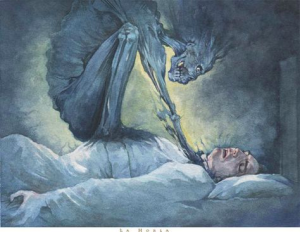 Hypnagogia is the experience of the transitional state from wakefulness to sleep.
Hypnagogia is the experience of the transitional state from wakefulness to sleep.
The hypnagogic state of consciousness, occurs during the onset of sleep.
Hypnopompic is the transitional state from sleep into wakefulness.
Mental phenomena that may occur during this state include hypnagogic hallucinations, lucid thought, exploding head syndrome, lucid dreaming, and sleep paralysis.
Hypnagogic phenomena may be interpreted as visions, prophecies, premonitions, apparitions and inspiration, depending on the experiencers’ beliefs and those of one’s culture.
The transition to and from sleep may be associated with a wide variety of sensory experiences, of any modality, and ranges from barely perceptible to vivid hallucinations.
Commonly reported sensory features of hypnagogia: random speckles, lines, geometrical patterns, or figurative images.
Imaging may be monochromatic or
colored, still, moving, flat or three-dimensional.
Images are typically fleeting with rapid changes.
Hypnagogic imagery is usually static and lacking in narrative content, compared to dreams.
Some who have spent a long time at some repetitive activity before sleep may experience that imagery as they grow drowsy (the Tetris effect).
The Tetris effect can manifest in other sensation modalities.
Hypnagogic hallucinations are often auditory or have an auditory component.
Hypnagogic sounds vary in intensity from faint impressions to loud noises, like knocking and crashes and bangs,
imagining their own name called, crumpling bags, white noise, or a doorbell ringing, and
imagined speech.
Hypnagogic sounds are typically nonsensical and fragmented, but occasionally strike the individual as apt comments on, or summarize of their thoughts at the time.
Hypnagogic sounds often contain word play, neologisms and made-up names, and may manifest as the subject’s own voice, or as the voices of others.
Rarely, poetry or music is heard during hypnagogia.
Gustatory, olfactory and thermal sensations as well as tactile sensations, paresthesia, formication, synesthesia, flashing of light or some other visual image in response to a real sound, proprioceptive effects may be noticed, with numbness and changes in perceived body size and proportions, feelings of floating or bobbing as if their bed were a boat, and out-of-body experiences, falling sensation, and associated hypnic jerk, are encountered by many people, at least occasionally, while drifting off to sleep.
Thought processes on the edge of sleep tend to differ from those of ordinary wakefulness, involving ego boundaries, openness, sensitivity, empathy and attention.
Hypnagogic cognition is characterized by heightened suggestibility, illogic and a fluid association of ideas, receptiveness to external stimuli of thought.
EEG readings during hypnagogia show elevated responsiveness to sound around the onset of sleep.
Hypnagogic hallucinations seem to represent whatever one is thinking at the time, turning abstract ideas into a concrete image.
The hypnagogic state can provide insight into a problem.
Many artists, writers, scientists and inventors have credited hypnagogia and related states with enhancing their creativity.
Hypnagogia can solve problems by individuals critically examining hallucinatory images before their eyes.
A feature of hypnagogia is amnesia, which is a selective forgetfulness, affecting the hippocampal memory system.
The hippocampal memory system is responsible for episodic or autobiographical memory, rather than the neocortical memory system, responsible for semantic memory.
Hypnagogia in the sense of spontaneous sleep onset experiences are associated especially with stage 1 of NREM sleep, but may also occur with pre-sleep alpha waves.
Short flashes of dreamlike imagery at the onset of sleep correlate with drop-offs in alpha EEG activity.
Sleep onset hypnagogia may be a state distinct from both wakefulness and sleep with unique electrophysiological, behavioral and subjective characteristics.
Respiratory pattern changes have also been noted in the hypnagogic state.
There is a lowered rate of frontalis muscle activity in hypnagogia.
